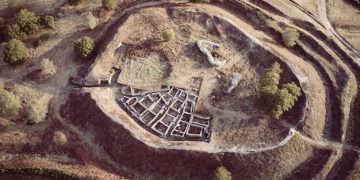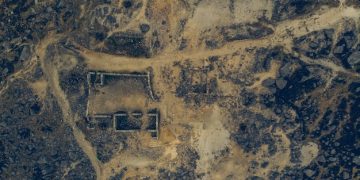The Search for Lost Colonies: Uncovering Early European Settlements in North America

The Search for Lost Colonies: Uncovering the Truth Behind Early European Settlements in North America delves into the mysteries and challenges faced by early European settlers. Archaeological findings offer valuable insights into these settlements, revealing stories of resilience, adaptation, and eventual disappearance.
The allure of the New World beckoned Europeans with promises of land, wealth, and freedom. Yet, the early chapters of European settlement in North America are often shrouded in mystery. What happened to those first intrepid colonists? Where did they go, and what can archaeological evidence tell us about their lives and disappearances? The Search for Lost Colonies: Uncovering the Truth Behind Early European Settlements in North America is an ongoing endeavor, piecing together fragments of the past to understand these pivotal moments in history.
Unveiling the Enigma: The Search for Lost Colonies in North America
The quest to understand the fate of lost colonies represents a fascinating intersection of history and archaeology. These ventures, initiated by European powers, often faced immense hardships, leading to their eventual abandonment or, in some cases, complete disappearance. Understanding the challenges faced by these early settlers is crucial to comprehending the broader narrative of North American colonization. The search for these lost colonies continues to captivate historians and archaeologists alike.
Early Colonial Ventures and Their Fates
Several early European settlements met unfortunate ends. Jamestown, though eventually successful, faced near-collapse multiple times. The Roanoke colony, however, remains the most famous example of a true “lost colony,” its inhabitants vanishing without clear explanation. These cases highlight the precarious nature of early colonial life.
- Roanoke: The mysterious disappearance of the entire colony remains one of the greatest unsolved puzzles in American history.
- Jamestown: Initial struggles with disease, famine, and conflict with Native Americans nearly doomed the settlement.
- Popham Colony: This short-lived colony in Maine faced harsh winters, internal conflicts, and ultimately, abandonment.
The search for answers regarding these settlements involves meticulous archaeological work. Examining artifacts, structures, and burial sites can reveal clues about the colonists’ lives, interactions with indigenous populations, and the factors that may have contributed to their demise. The process is often slow and painstaking, but the potential rewards are significant.

The Role of Archaeology in The Search for Lost Colonies
Archaeology serves as a critical tool in reconstructing the narratives of these early settlements. By carefully excavating sites and analyzing the recovered artifacts, archaeologists can piece together a more complete picture of colonial life. This includes gaining insights into their diet, lifestyle, trade, and interactions with the surrounding environment. The Search for Lost Colonies: Uncovering the Truth Behind Early European Settlements in North America relies heavily on these archaeological endeavors.
Techniques and Discoveries in Colonial Archaeology
Modern archaeological techniques have revolutionized our understanding of colonial sites. Ground-penetrating radar, LiDAR, and advanced dating methods provide invaluable data. Analysis of skeletal remains can reveal information about diet, disease, and even cause of death, shedding light on the hardships endured by these early settlers.
The use of advanced technology is becoming increasingly important, especially when trying to locate and analyze objects and grounds that remained untoched for centuries. For example, when searching for The Search for Lost Colonies: Uncovering the Truth Behind Early European Settlements in North America, advanced technologies may be the only way to actually find any findings.
- Ground-Penetrating Radar (GPR): Used to identify subsurface features without excavation.
- LiDAR (Light Detection and Ranging): Creates detailed topographical maps to locate potential sites.
- Isotopic Analysis: Examines the chemical composition of bones and artifacts to determine origin and diet.
Through these methods, archaeologists have made significant discoveries at sites like Jamestown, revealing the true extent of the colonists’ struggles. Similar techniques are being applied at other colonial sites, offering hope for uncovering the mysteries surrounding lost settlements.
Roanoke: America’s Most Enduring Mystery
The disappearance of the Roanoke colony stands as one of the most perplexing enigmas in American history. Founded in 1587, the colony was intended to be a permanent English settlement in the New World. However, when Governor John White returned from England in 1590, he found the settlement deserted, with no clear signs of what had transpired. All that remained was the cryptic word “CROATOAN” carved into a post. The Search for Lost Colonies: Uncovering the Truth Behind Early European Settlements in North America often leads back to this haunting example.
Theories Surrounding the Roanoke Disappearance
Numerous theories have been proposed to explain the fate of the Roanoke colonists, ranging from assimilation with Native American tribes to disease, starvation, and violent conflict. Despite extensive research, no single theory has been definitively proven, leaving the mystery largely unsolved.
- Assimilation: The colonists integrated with local Native American tribes, such as the Croatan.
- Disease and Starvation: A harsh winter and lack of supplies led to widespread death.
- Conflict: Clashes with Native Americans resulted in the colony’s destruction.
Archaeological investigations on Roanoke Island and surrounding areas have yielded some clues but no definitive answers. The search continues, with researchers focusing on potential sites on Hatteras Island, believed to be the home of the Croatan tribe. The mystery of Roanoke remains a compelling challenge for historians and archaeologists.

Jamestown: From Near Collapse to Success
The story of Jamestown offers a contrasting narrative to that of Roanoke. Established in 1607, Jamestown was the first permanent English settlement in North America. However, the colony faced immense challenges in its early years, including disease, famine, and conflict with the Powhatan Confederacy. The Search for Lost Colonies: Uncovering the Truth Behind Early European Settlements in North America also involves understanding the factors that differentiated surviving colonies like Jamestown from those that vanished.
Archaeological Discoveries at Jamestown
Excavations at Jamestown have revealed a wealth of information about the colonists’ lives and struggles. The discovery of the “starving time” trash pits provided stark evidence of the extreme famine the colonists endured during the winter of 1609-1610. Skeletal remains have also revealed signs of violence and cannibalism, painting a grim picture of survival against all odds.
- The “Starving Time” Evidence: Archaeological findings confirmed the severity of the famine.
- Fort James: The rediscovery of the original fort revealed its strategic importance.
- Colonial Burials: Analysis of skeletal remains provided insights into health and mortality.
Despite these hardships, Jamestown persevered, eventually becoming a successful tobacco-producing colony. The archaeological record reveals the resilience and adaptability of the colonists, as well as the crucial role of leadership and changing economic conditions in the colony’s survival.
Beyond Roanoke and Jamestown: Other Lost Settlements
While Roanoke and Jamestown are the most well-known, several other early European settlements in North America also faced abandonment or disappearance. The Popham Colony in Maine, the French settlement of Charlesfort in South Carolina, and various Spanish missions throughout the Southeast all met similar fates. Each of these sites offers unique insights into the challenges and complexities of early colonization.
Exploring Lesser-Known Colonial Sites
These lesser-known colonial sites often receive less attention than Roanoke or Jamestown, but they are equally important in understanding the broader history of European settlement. Archaeological investigations at these sites can reveal diverse experiences and perspectives, challenging traditional narratives of colonization.
- Popham Colony: Investigating the reasons for its rapid abandonment.
- Charlesfort: Uncovering the dynamics of French-Spanish rivalry in the New World.
- Spanish Missions: Examining the impact of religious conversion on Native American populations.
The search for these lost settlements involves interdisciplinary collaboration, combining historical research, archaeological fieldwork, and community engagement. By working together, researchers can piece together the stories of these forgotten colonies and gain a more comprehensive understanding of the past.
| Key Point | Brief Description |
|---|---|
| 🔎 Roanoke Mystery | The colony disappeared, leaving “CROATOAN” carved. |
| 🌱 Jamestown Struggles | Early hardships included famine and conflict. |
| 🏛️ Colonial Archaeology | Artifacts reveal insights into colonial life. |
| 🌍 Other Settlements | Sites like Popham and Charlesfort faced similar fates. |
Frequently Asked Questions
Roanoke is a prime example of a lost colony, its unexplained disappearance sparking centuries of speculation and archaeological investigation. Its story highlights the challenges of early colonization.
Archaeology provides tangible evidence through artifacts, structures, and burial sites, offering insights into the daily lives, struggles, and interactions of the early colonists.
Early European settlements faced challenges like disease, famine, conflict with Native Americans, and harsh environmental conditions, all contributing to their precarious existence.
Theories include assimilation with Native American tribes, death by disease or starvation, and violent conflict. However, no single theory has been definitively proven, preserving the mystery of the colony.
While Jamestown also faced immense hardships, it ultimately persevered and became a successful colony, providing valuable insights into survival factors not present in Roanoke.
Conclusion
The Search for Lost Colonies: Uncovering the Truth Behind Early European Settlements in North America is a continuing endeavor, driven by the desire to understand the past and honor the experiences of those who came before us. By combining historical research with modern archaeological techniques, we can continue to piece together the stories of these lost settlements and gain a more complete understanding of the complex history of North American colonization.





